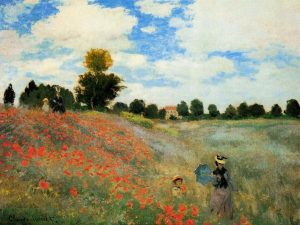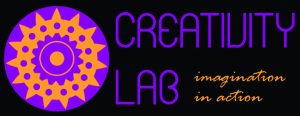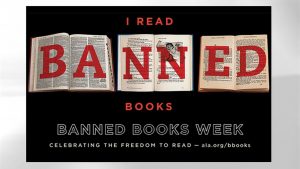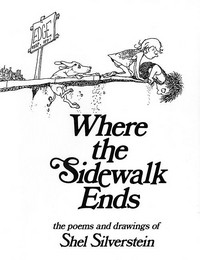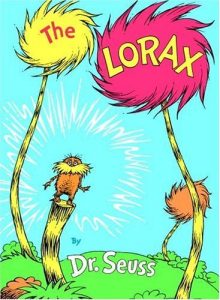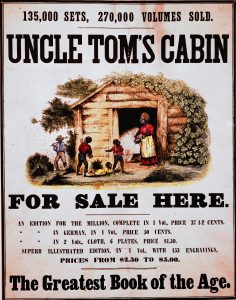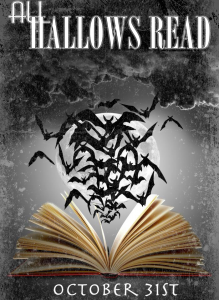
The time has come again, beloved patrons, for All Hallows Read, a monthly indulgence in all things spectacularly spooky, deliciously dark, and gloriously ghoulish!
All Hallows Read was started by the Great and Good Neil Gaiman in 2010 with this blog post, which called for a new Halloween tradition, and stated, in part:
I propose that, on Hallowe’en or during the week of Hallowe’en, we give each other scary books. Give children scary books they’ll like and can handle. Give adults scary books they’ll enjoy.I propose that stories by authors like John Bellairs and Stephen King and Arthur Machen and Ramsey Campbell and M R James and Lisa Tuttle and Peter Straub and Daphne Du Maurier and Clive Barker and a hundred hundred others change hands — new books or old or second-hand, beloved books or unknown. Give someone a scary book for Hallowe’en. Make their flesh creep…
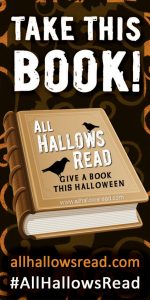
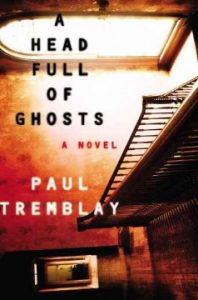 A Head Full of Ghosts: This book, man. Oh, this book. First off, it’s set in Beverly, and Paul Tremblay is a Massachusetts native, so there is a good deal of (accurate) local flair. Second, it features a whole bunch of unreliable narrators: beginning with Merry, who is relating the story of her older sisters alleged possession, the reality television series that invaded her family’s lives in order to film their trauma, and the blogger who analyzes the reality show in stand-alone chapters. Third, its will keep you guessing and wondering and questioning from the very first scene, doubting what is true, what is really happening, and just how much you as a reader are willing to believe in the power of evil, which makes for a genuinely engaging, and unnerving read. Fourth, it has one of the biggest, best twists in the history of literary twists. So much so that I made my dad read this book so that I could discuss it with someone. He agrees with me. As does Stephen King, who said that this book “Scared the living hell out of me, and I’m pretty hard to scare.”
A Head Full of Ghosts: This book, man. Oh, this book. First off, it’s set in Beverly, and Paul Tremblay is a Massachusetts native, so there is a good deal of (accurate) local flair. Second, it features a whole bunch of unreliable narrators: beginning with Merry, who is relating the story of her older sisters alleged possession, the reality television series that invaded her family’s lives in order to film their trauma, and the blogger who analyzes the reality show in stand-alone chapters. Third, its will keep you guessing and wondering and questioning from the very first scene, doubting what is true, what is really happening, and just how much you as a reader are willing to believe in the power of evil, which makes for a genuinely engaging, and unnerving read. Fourth, it has one of the biggest, best twists in the history of literary twists. So much so that I made my dad read this book so that I could discuss it with someone. He agrees with me. As does Stephen King, who said that this book “Scared the living hell out of me, and I’m pretty hard to scare.”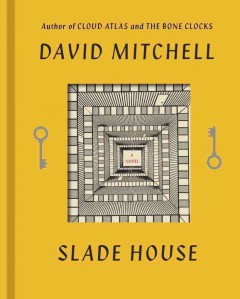 Slade House: I am going to put it out there–I have never been so scared by a book, and so annoyed at its author at the same time as I was when reading David Mitchell’s first official foray into the gothic horror genre. The book itself is made up of intertwined short stories, each taking place on the same day in different years, and each set at the titular Slade House, which only appears to those looking for it. Even as my rational brain was telling me that Slade House was a trap, that no good could come to those hunting for it, or searching through it, or trying to escape from it, I was genuinely scared while reading of the way that Slade House toyed with its victims, turned their realities inside-out and upside-down, and destroyed them. Those looking for a truly dread-full read should look no further than this odd little yellow volume (and those who have read Mitchell’s The Bone Clocks will find an added treat in the ending).
Slade House: I am going to put it out there–I have never been so scared by a book, and so annoyed at its author at the same time as I was when reading David Mitchell’s first official foray into the gothic horror genre. The book itself is made up of intertwined short stories, each taking place on the same day in different years, and each set at the titular Slade House, which only appears to those looking for it. Even as my rational brain was telling me that Slade House was a trap, that no good could come to those hunting for it, or searching through it, or trying to escape from it, I was genuinely scared while reading of the way that Slade House toyed with its victims, turned their realities inside-out and upside-down, and destroyed them. Those looking for a truly dread-full read should look no further than this odd little yellow volume (and those who have read Mitchell’s The Bone Clocks will find an added treat in the ending).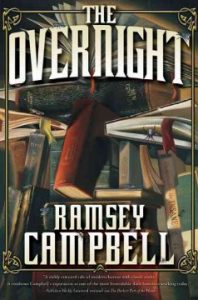 The Overnight: Ramsey Campbell is one of the masters of horror fiction, and has contributed an enormous amount to the genre as a whole. Though not one of his most famous works, this tale, set in a chain bookstore run by an American on British soil, was too appropriate to pass over. Woody, the manger of Texts (the bookstore in question) wants nothing more than to make his store into a calm, orderly, peaceful place for customers to browse and buy. But every day when he and his staff enter the store, the books are tossed on the floor, broken, bent…and mysteriously damp. The store’s computers literally have a mind of their own, ringing up stocking and purchasing errors at random. And the employees, too, are falling apart–bickering, accusing, and one has even lost the ability to read at all. Desperate for answers, Woody demands his staff remain overnight in the store to perform a final stock count…and together, they discover the hell that really lurks on the shelves….This book is told from the point of view of each of the employees in turn, which may make it a tricky read for some, but it also helps create an atmosphere of tension and suspense throughout that works very, very well.
The Overnight: Ramsey Campbell is one of the masters of horror fiction, and has contributed an enormous amount to the genre as a whole. Though not one of his most famous works, this tale, set in a chain bookstore run by an American on British soil, was too appropriate to pass over. Woody, the manger of Texts (the bookstore in question) wants nothing more than to make his store into a calm, orderly, peaceful place for customers to browse and buy. But every day when he and his staff enter the store, the books are tossed on the floor, broken, bent…and mysteriously damp. The store’s computers literally have a mind of their own, ringing up stocking and purchasing errors at random. And the employees, too, are falling apart–bickering, accusing, and one has even lost the ability to read at all. Desperate for answers, Woody demands his staff remain overnight in the store to perform a final stock count…and together, they discover the hell that really lurks on the shelves….This book is told from the point of view of each of the employees in turn, which may make it a tricky read for some, but it also helps create an atmosphere of tension and suspense throughout that works very, very well.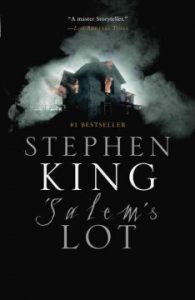 ‘Salem’s Lot: I am pretty sure there is some kind of limit about how many times I can recommend a book. But since I have read this book every year since 2009, and still love it (and still find it scary), I’m going to recommend it again. Set in the township of Jerusalem’s Lot, Maine, Stephen King’s book is at once a tale of the undead horror that unravels the town from the inside out, but it is also a love story to autumn in New England that is just as easy to relate to now as it was when the book was published in 1975. I’m in the middle of my eighth reading of this book, and still finding new treasures in it–and still creeped out about that scene in the graveyard.
‘Salem’s Lot: I am pretty sure there is some kind of limit about how many times I can recommend a book. But since I have read this book every year since 2009, and still love it (and still find it scary), I’m going to recommend it again. Set in the township of Jerusalem’s Lot, Maine, Stephen King’s book is at once a tale of the undead horror that unravels the town from the inside out, but it is also a love story to autumn in New England that is just as easy to relate to now as it was when the book was published in 1975. I’m in the middle of my eighth reading of this book, and still finding new treasures in it–and still creeped out about that scene in the graveyard.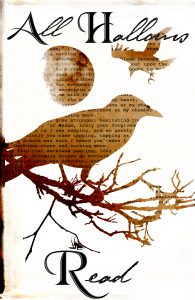

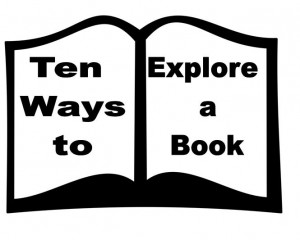
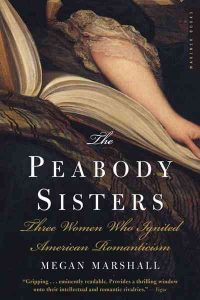
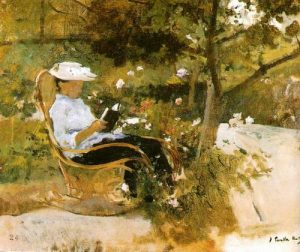
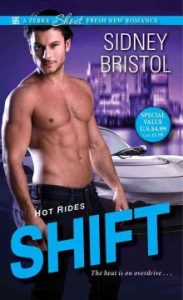 This book seemed, at first, to be way outside my literary comfort zone, but within only a few pages, I was completely hooked, and totally captivated by Bristol’s brilliant characterization and fiercely emotional love story. The series as a whole focuses on the employees of a classic car garage, who are all tough, fearless street racers…and who are all also undercover government agents (usually as a way to pay down some sort of debt they owe to Uncle Sam, or because they have a personal stake in the mission at hand).
This book seemed, at first, to be way outside my literary comfort zone, but within only a few pages, I was completely hooked, and totally captivated by Bristol’s brilliant characterization and fiercely emotional love story. The series as a whole focuses on the employees of a classic car garage, who are all tough, fearless street racers…and who are all also undercover government agents (usually as a way to pay down some sort of debt they owe to Uncle Sam, or because they have a personal stake in the mission at hand).
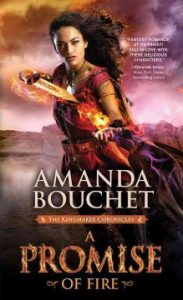 First time novelist Amanda Bouchet has given the gift of a completely addictive fantasy romance to genre fans everywhere.
First time novelist Amanda Bouchet has given the gift of a completely addictive fantasy romance to genre fans everywhere. 